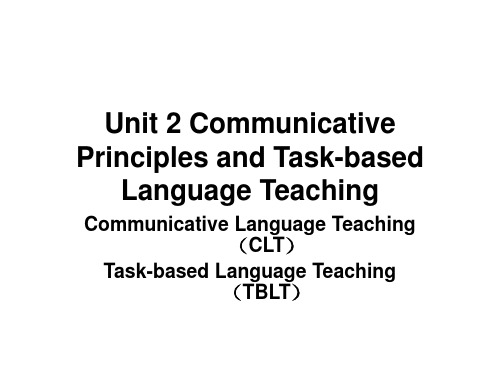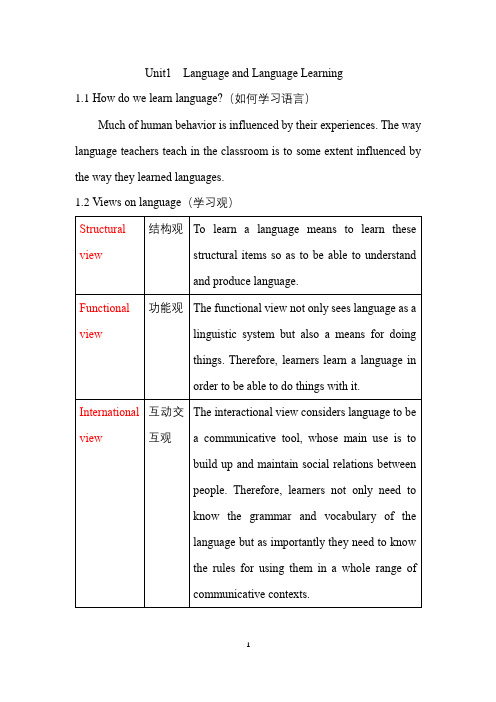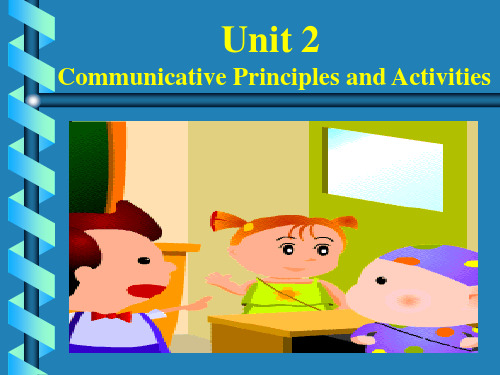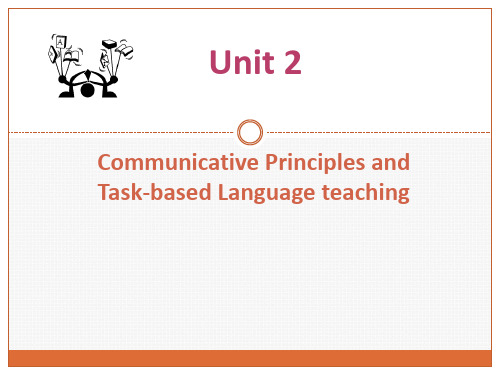Unit 2 communicative principles and task
- 格式:doc
- 大小:20.50 KB
- 文档页数:2


Unit1 Language and Language Learning1.1How do we learn language?(如何学习语言)Much of human behavior is influenced by their experiences. The way language teachers teach in the classroom is to some extent influenced by the way they learned languages.1.2Views on language(学习观)1.3Views on language learning and learning in generalNow, the research about language learning theories can be broadly divided into two parts. They are Process-oriented theories and Condition-oriented theories. Some researchers attempt to formulate teaching approaches directly from these theories. For example, the Natural Approach, Total physical Response, and the Silent Way are based on one or more dimensions of processes and conditions. Here are What is done in these processes.1.4What makes a good language teacher?(好教师的素质要素)①Ethic devotion ②Professional qualities ③Personal styles1.5How can we become a good language teacher?(如何成为一名好的语言老师)The most important and difficult part of the making of a good language teacher is the development of professional competence, which is the state or quality of being adequately qualified for the profession, and armed with a specific range of skills, strategies, knowledge, and ability.Teacher’s professional development1.6An overview of the bookUnit2 Communication Principles and Task-based Language Teaching 2.1 Language use in real life vs. traditional pedagogy2.2 What is communicative competence?communicative competence includes both the knowledge about the language and the knowledge about how to use the language appropriately in communicative situation.2.3 Implications for teaching and learning (略)2.4 Principles of Communicative Language Teaching(CLT)1)Communication principle: Activities that involves real communication promote learning.2) Task principle: Activities in which language is used for carry out meaningful tasks promote learning.3) Meaningfulness principle: Language that is meaningful to the learner supports the learning process.2.5 CLT and the teaching of language skills2.6 Main features of Communicative activities2.7 Task-based Language Teaching(TBLT)Task-based Language Teaching is, in fact, a further development of Communicative Language Teaching.2.7.1 Definitions of a task√√2.7.2 Four components of a task.1) A purpose: making sure the students have a reason for undertaking the task.2) A context: this can be real, simulated, or imaginary, and involves sociolinguistic issues such as the location, the participants and their relationship, the time, and other important factors.3) A process: getting the students to use learning strategies such as problemsolving, reasoning, inquiring, conceptualizing and communicating.4) A product: there well be some form of outcome, either visible(written plan, a play, a letter, etc.) or invisible (enjoying a story, learning about another country, etc.)2.7.3 Exercises, exercise-tasks and taskexercise exercise-task task2.8 PPP and Task-based Language TeachingMany teachers may be familiar with the Presentation, Practice and Production(PPP). A typical PPP lesson would start by the teacher introducing a new language item in a context followed by some controlled practice, such as drilling, repetition, dialogue reading, etc. Students then move on to produce the language in a more meaningful way, such as a role play, a drama, an interview, etc. Some teachers may also be familiar with the five-step teaching method, which is quite similar to the PPP model but adding revision at the beginning and consolidation at the end.2.8.1 Differences between PPP and TBL1) The way students use and experience language in TBL is rapidly different from PPP.2) TBL can provide a context for grammar teaching and form-focused activities. PPP is different in this aspect.2.9 How to design tasks?√√2.10 Appropriateness of CLT and TBLT in the Chinese context1)The problems of CLT: ①If CLT is culturally appropriate.(Both its advantages and constraints are recognized by teachers and students.)②It is very difficult to design a syllabus with a one to one correspondence between a function and a form.2)The problems of TBLT: ①It may not be effective for presenting new language items.(Swan,2005) ②Time. Teachers have to prepare task-based activities very carefully. ③The culture of learning. Some students may find it difficult to adapt to TBLT. ④The level of difficulty. Students mayfind task-based learning quite difficult if they do not have sufficient linguistic resources to handle holistic communication.2.11 ConclusionIt is important to remember that a method is effective only when it is appropriate to the teaching context. Therefore, when a new method or approach emerges, it is unwise to simply cast away the traditional and follow the new trend. The best thing to do is to develop one’s own teaching methods based on the context where one teaches and integrates the merits of different methodologies to serve the purpose of one’s teaching objectives and the needs of one’s students.Unit3 The National English Curriculum3.1 A brief history of foreign language teaching in ChinaUnit4 Lesson Planning4.1 Why is lesson planning important?Definition: A lesson plan is a framework of a lesson in which teachers make advance decisions about what they hope to achieve and how they would like to achieve it.Reasons: ①A clear lesson plan makes the teacher aware of the aims and language contents of the lesson.②It helps teachers distinguish thevarious stages of a lesson and see the relationship between them so that the activities of different difficulty levels can be arranged properly and the lesson can move smoothly from one stage to another.③Proper lesson planning gives teachers the opportunity to anticipate potential problems that may arise in class so that they can be prepared with some possible solutions or other options for the lesson. ④Good planning gives teachers, especially novice teachers confidence in class. ⑤When planning the lesson, the teacher also becomes aware of the teaching aids that are needed for the lesson.⑥Planning is a good practice and a sign of professionalism.4.2 Principles for good lesson planning4.3 Macro planning vs. micro planning.(宏观计划vs.微观计划)The components of macro planning:(宏观计划包含的内容)1)Knowing about the profession.2)Knowing about the institution.3)Knowing about the learners.4)Knowing about the curriculum/syllabus.5)Knowing about the textbook.6)Knowing about the objectives.4.4 Components of a lesson planDifferent teachers have different teaching styles and may use different teaching procedures, so ‘every lesson is unique’(Robertson and Acklam,2000:6), and so is every lesson plan. A lesson plan include many parts.Unit5 Classroom ManagementDefinition:Classroom management is the way teachers organize what goes on in the classroom.Goal:To create an atmosphere conductive to interacting in English in meaningful ways.(Gebhard,1996)Conditions for achieving classroom management:1)The teacher plays appropriate roles.2)The teacher provides clear instructions.3)Students are grouped in a way suitable for the learning activities.4)The teacher asks appropriate questions.5)There is discipline as well as harmony in the class.6)The students errors are treated properly.5.1 The role of the teacherWhat are the teacher’s roles defined by Harmer?①controller ②assessor ③organiser ④prompter ⑤participant⑥resource-providerWhat are teacher’s new roles?①facilitators ②guides ③researchers5.2 Classroom instructionsDefinition: Classroom instructions refer to the type of language teachers use to organize or guide learning. They include giving directions to tasks or activities; providing explanations to a concept or language structure; setting requirements; checking comprehension; drawing attention; motivating learners; giving feedback and assigning homework, etc. Generally they include all classroom language that teachers may use for teaching purposes as well as for managing teaching.What are rules to follow for making instructions effective?①To use simple instructions and make them suit the comprehensionlevel of the students.②To use the mother-tongue only when it is necessary.③To be careful not to do all the talking in class.。



王蔷《英语教学法教程(第二版)》讲义Unit1Language and Language LearningUnit2Communicative Principles and Task-based Language Teaching Unit3The National English CurriculumUnit4Lesson PlanningUnit5Classroom ManagementUnit6Teaching PronunciationUnit7Teaching GrammarUnit8Teaching VocabularyUnit9Teaching ListeningUnit10Teaching SpeakingUnit11Teaching ReadingUnit12Teaching WritingUnit13Integrated SkillsUnit14Moral LearningUnit15Assessment in Language TeachingUnit16Learner Differences and Learner TrainingUnit17Using and Creating ResourcesUnit18Evaluating and Adapting Textbooks语言和语言学习【考情分析】本章主要讨论语言观和语言学习观、优秀教师的基本素养以及如何成为一名优秀的英语教师。
主要考点:结构主义、功能主义和交互语言理论;行为主义、认知主义、建构主义和社会建构主义学习理论;一个好的语言老师必备的素养;教师专业技能发展等。
【知识框架】Unit1 Language and Language Learning Views on languageViews in generalA good language teacherFunctional viewBehaviourist theoryCognitive theoryConstructivist theorySocio-constructivist theoryInteractional viewHow can one becomea good language teacher?An overview of the bookethic devotionprofessional qualitiespersonal stylesStage1Language trainingStage2Learning,practiceand reflectionGoal语言和语言学习1.1How do we learn languages?We learn language at different agesPeople have different experiencesPeople learn languages for different reasonsPeople learn languages in different waysPeople have different understandingsPeople have different capabilities in language learningLearning can be affected by the way how language is taughtLearning is affected by the degree of success one is expect to achieve.Thus the challenge confronting language teaching is how teaching methodology can ensure successful learning by all the learners who have more differences than the commonality.1.2Views on languageIn the past century,language teaching and learning practice has been influenced by three different views of language,namely,the structural view,the functional view and the interactional view.(1)The structural view of language结构主义语言观The structural view of language sees language as a linguistic system made up of various subsystem(Larsen-Freeman&Long,1991):the sound system(phonology音系学);the discrete units of meanings produced by sound combinations(morphology形态学/词汇学),and the system of combining units of meaning for communication (syntax句法学).Each language has a finite number of such structural items.结构主义语言观:结构主义语言观将语言看作由许多子系统组成的语言学系统(Larsen-Freeman&Long,1991):语音系统(音系学);产生于语音集合的意义的离散单位(形态学),以及交际意义的集合单元系统(句法学)。

Unit 2 Communicative Principles and TBLT2.1 Language use in real life vs. traditional pedagogy①Focus: In real life, language is used to perform certain communicative functions, (e. g .to give directions, to exchange information, or to make a complaint) in a traditional language classroom, the teaching focus is often on forms rather than functions.②Skills: Traditional pedagogy tends to focus on one or two language skills and ignore the others. In real language use we use all skills, including receptive skills such as listening and reading, and productive skills such as speaking and writing.③Context: In reality language is always used in a certain context, but traditional pedagogy tends to isolate language from its context.2.2 What is communicative competence?①名词解释:⑴Communicative competence is the goal of Communicative Language Teaching, which includes both the knowledge of the language itself and the knowledge of how to use language appropriately in communicative situations.⑵Five main components of communicative competence are linguistic competence, pragmatic competence, discourse competence, strategic competence, and fluency.②简答:①+the main components of communicative competence.(每个competence的⑴)③论述:②+In other words, it is one’s ability to express or to understanda topic logically and coherently by effectively employing or comprehending the cohesive markers used in the discourse such as “by the same token”, “at last” and also the reference words such as “it”, “they”, etc. in the context.2.3 What are the main components of communicative competence?(每个competence都可以出名词解释,回答⑴⑵)Five main components of communicative competence are linguistic competence, pragmatic competence, discourse competence, strategic competence, and fluency.①Linguistic competence:⑴It is concerned with the knowledge of the language itself, its form and meaning.⑵More specifically, it involves spelling, pronunciation, vocabulary, wordformation, grammatical②Pragmatic competence:⑴Pragmatic competence is concerned with the appropriate of the language in social context.⑵That is to say, the choice of the vocabulary and structure depends on the setting, the relative status of the speakers, and their relationships.③Discourse competence:⑴Discourse competence refers to one’s ability to create coherent written text or conversation and the ability to understand them.⑵In other words, it is one’s ability to express or to understand a topic logically and coherently by effectively employing or comprehending the cohesive markers used in the discourse such as :“by the same token”, “to put it in other words”,“first”,“second”,“at last”, and also the reference words such as“it”,“they”,“that”,etc. in the context.④Strategic competence:⑴Strategic competence refers to strategies one employs when there is communication breakdown due to lack of resources.⑵One can compensate for this by searching for other means of expressions, such as using a similar phrase, using gestures, or using a longer explanation.⑤Fluency: It means one’s ability to “link units of speech together with facility and without strain or inappropriate slowness or undue hesitation”2.4 What is CLT(名词解释)?①CLT refers to Communicative Language Teaching. It is one type of teaching method to cultivate communicative competence.②The goal of CLT is to make students know the knowledge of the language and the knowledge about how to use language appropriately in communicative situations. That’s to say, CLT not only focus on the linguistic knowledge but the functions of language such as advising, inviting suggesting, etc., which students should learn how to use.③The principles of CLT are communicative, task and meaningfulnessprinciples.④There are two versions of CLT proposed by Howatt, to describe the ways of language learning.2.5 What are the criteria for evaluating how communicative classroom activities are?①Communicative purpose: The activity must involve the students in performing a real communicative purpose rather than just practicing language for its own sake.②Communicative desire: The activity must create desire to communicate in the students. That is, even if communication is forced on the students, they must feel a real need to communicate.③Content, not form: When the students are doing the activity, they must be concentrating on what they are saying, not how they say it.④Variety of language: The activity must involve the students in using a variety of language, not just one specific language form.⑤No teacher intervention:The activity must be designed to be done by the students working by themselves rather than with the teacher.⑥No material control: The activity should not be designed to control what language the students should use. The choice about what language to use should rest with the students.2.6 How do you understand Task-based Language Teaching? (TBLT)(名词解释)①Task-based Language Teaching (TBLT)refers to an approach based on the use of task as the core unit of instruction in language.②Task-based Language Teaching is, in fact, a further development of Communicative Language Teaching.③It shares the same beliefs, as language should be learned as close as possible to how it is used in real life.④However, it has stressed the importance to combine form-focused teaching with communication-focused teaching.2.7 What does a task refer to? (名词解释)[A task is] an activity which requires learners to arrive at an outcome from given information through some process of thought, and which allows teachers to control and regulate that process.2.8 What are the four components of a task? (PPP+C)A task has four main components: a purpose, a process, a product and a context.①a purpose: making sure the students have a reason for undertaking the task②a process: getting the students to use learning strategies such as problem solving, reasoning, inquiring, conceptualizing and communicating③a product: there will be some form of outcome, either visible or invisible④a context: this can be real, simulated or imaginary, and involves sociolinguistic issues2.9 What are the differences between tasks and exercises?①When the students are carrying out a task, they are focusing on the complete act of communication. (fluency)②When the students focus their attention on individual aspects of language, such as vocabulary, grammar or individual skills. We can call these activities exercise. (accuracy)2.10 What is PPP?(名词解释:①②)①It refers to Presentation, Practice and Production model of teaching.②At the presentation stage, the teacher introduces new vocabulary and grammatical structures in whatever ways appropriate. At the practice stage, the lesson moves from controlled practice to guided practice and exploitation of the texts when necessary. At the production stage, the students are encouraged to use what they have learned and practiced to perform communication tasks. At the last stage, the focus is on meaning rather than accurate use of language forms.③Some of the advantages of the PPP model are that first it is clear and easy to conduct by the teachers. Secondly, it is easy to evaluate as there are often clear goals to be obtained. Thirdly, there is the belief that learning with a focus on rules can be automatized through practice as “ a set of habits”.④The disadvantage is that students will not automatically acquire the language and use them in real life if only rules are introduced and mechanical exercises are emphasized.2.11 How to design tasks?①Think about students’ needs, interest, and abilities②Brainstorm possible tasksBear in mind that a task should have a communicative purpose and should be goal-oriented.③Evaluate the listAfter you have brain stormed the possible tasks, you can use the following criteria to evaluate them.⚫Educational value⚫Appropriateness to the students’ needs, interests and abilities⚫Availability of suitable resources⚫Time available④Choose the language items⑤Preparing the materials。